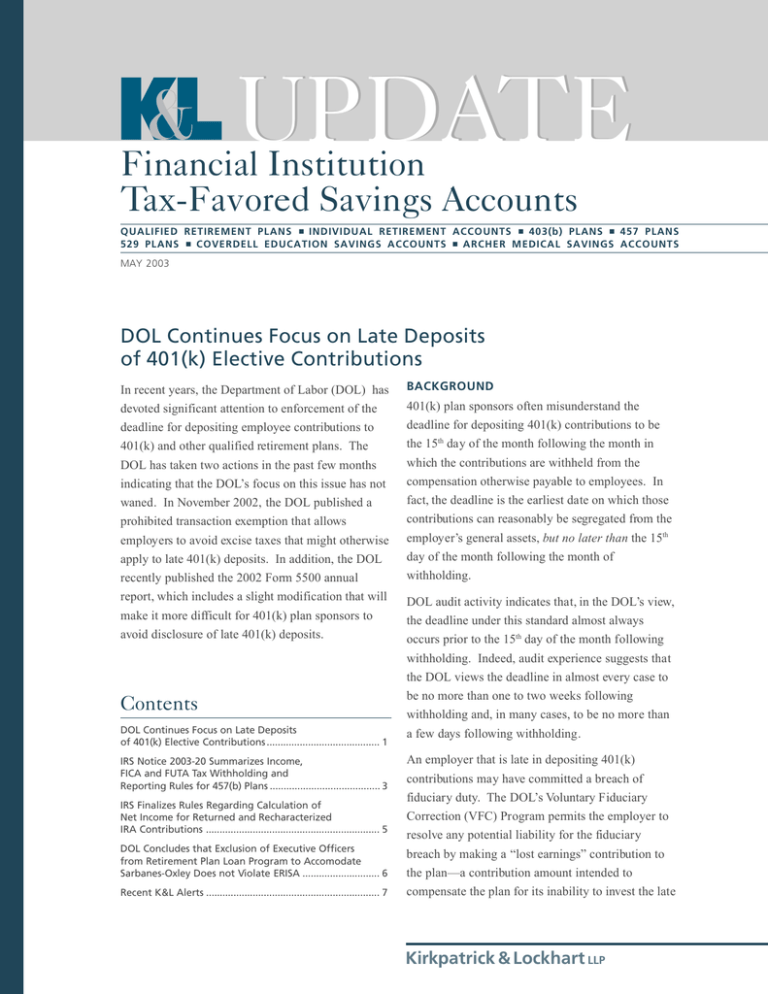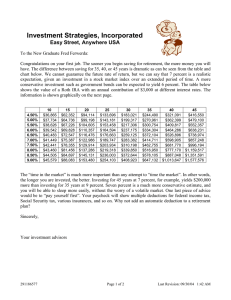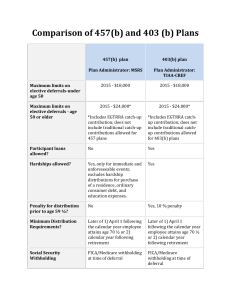
UPDATE
Financial Institution
Tax-Favored Savings Accounts
QUALIFIED RETIREMENT PLANS ■ INDIVIDUAL RETIREMENT ACCOUNTS ■ 403(b) PLANS ■ 457 PLANS
529 PLANS ■ COVERDELL EDUCATION SAVINGS ACCOUNTS ■ ARCHER MEDICAL SAVINGS ACCOUNTS
MAY 2003
DOL Continues Focus on Late Deposits
of 401(k) Elective Contributions
In recent years, the Department of Labor (DOL) has
devoted significant attention to enforcement of the
deadline for depositing employee contributions to
401(k) and other qualified retirement plans. The
DOL has taken two actions in the past few months
indicating that the DOL’s focus on this issue has not
waned. In November 2002, the DOL published a
prohibited transaction exemption that allows
employers to avoid excise taxes that might otherwise
apply to late 401(k) deposits. In addition, the DOL
recently published the 2002 Form 5500 annual
report, which includes a slight modification that will
make it more difficult for 401(k) plan sponsors to
avoid disclosure of late 401(k) deposits.
Contents
DOL Continues Focus on Late Deposits
of 401(k) Elective Contributions ......................................... 1
IRS Notice 2003-20 Summarizes Income,
FICA and FUTA Tax Withholding and
Reporting Rules for 457(b) Plans ........................................ 3
IRS Finalizes Rules Regarding Calculation of
Net Income for Returned and Recharacterized
IRA Contributions ............................................................... 5
DOL Concludes that Exclusion of Executive Officers
from Retirement Plan Loan Program to Accomodate
Sarbanes-Oxley Does not Violate ERISA ............................ 6
Recent K&L Alerts ............................................................... 7
BACKGROUND
401(k) plan sponsors often misunderstand the
deadline for depositing 401(k) contributions to be
the 15th day of the month following the month in
which the contributions are withheld from the
compensation otherwise payable to employees. In
fact, the deadline is the earliest date on which those
contributions can reasonably be segregated from the
employer’s general assets, but no later than the 15th
day of the month following the month of
withholding.
DOL audit activity indicates that, in the DOL’s view,
the deadline under this standard almost always
occurs prior to the 15th day of the month following
withholding. Indeed, audit experience suggests that
the DOL views the deadline in almost every case to
be no more than one to two weeks following
withholding and, in many cases, to be no more than
a few days following withholding.
An employer that is late in depositing 401(k)
contributions may have committed a breach of
fiduciary duty. The DOL’s Voluntary Fiduciary
Correction (VFC) Program permits the employer to
resolve any potential liability for the fiduciary
breach by making a “lost earnings” contribution to
the plan—a contribution amount intended to
compensate the plan for its inability to invest the late
Kirkpatrick & Lockhart LLP
contributions between the deposit deadline and the
date of actual deposit.
Historically, the VFC Program has not been popular
with employers. Although many employers are
willing to, and in fact do, correct late deposits by
making lost earnings contributions in the manner
specified by the VFC Program, there seems to be a
general reluctance of employers to voluntarily
disclose administrative errors to government
enforcement agencies. Also, employers typically
have preferred not to make a formal VFC filing on
the theory that the costs associated with the filing
outweigh the risk of a DOL enforcement action with
respect to a deposit that is late by perhaps just a few
days and corrected in the manner otherwise required
by the VFC Program.
Further, a 401(k) plan sponsor that is late in
depositing 401(k) contributions may have committed
a prohibited transaction, since the retention of the
contributions after the deadline and prior to deposit
can be viewed as a loan from the plan to the plan
sponsor. The prohibited transaction triggers an
excise tax equal to 15% of the amount involved,
payable to the Internal Revenue Service on Form
5330. The excise tax continues to accrue until the
prohibited transaction is corrected (i.e., the
contributions, including lost earnings, are deposited).
A lost earnings contribution calculated in accordance
with the methodology used to resolve the breach of
fiduciary duty under the VFC Program would
constitute a correction of the prohibited transaction.
PROHIBITED TRANSACTION
EXEMPTION 2002-51
In November 2002, the DOL published a prohibited
transaction exemption (PTE 2002-51) that
characterizes the failure to timely deposit 401(k)
elective deferral contributions as an exempt
prohibited transaction under certain circumstances.
If the exemption is available, the 15% excise tax
does not apply.
The exemption is available only where the plan
sponsor satisfies the following conditions:
2
■
The contributions must be deposited in the plan’s
trust no later than 180 days following the date of
withholding.
■
The plan sponsor must resolve the breach of
fiduciary duty by applying for and obtaining a no
action letter from the DOL under the VFC
Program.
■
The plan sponsor must deliver notice to
“interested persons” within 60 calendar days
following the date of the VFC Program
application. Interested persons include plan
participants and beneficiaries. The notice must
disclose the late contribution and explain the steps
taken to correct it. The notice must also provide
interested persons with a period of 30 calendar
days, beginning on the date the notice is
distributed, to provide comments to the DOL.
A plan sponsor may not take advantage of the
exemption more than once during any three-year
period.
The notice requirement and the requirement that the
plan sponsor utilize the VFC Program to resolve the
breach of fiduciary duty may dissuade some plan
sponsors from relying on PTE 2002-51 to avoid the
15% excise tax.
In this regard, many plan sponsors do not wish to
prominently disclose late 401(k) contributions to
plan participants and beneficiaries—even where the
plan sponsor corrects the breach of fiduciary duty
and the prohibited transaction by making a lost
earnings contribution. Moreover, as described
above, many plan sponsors prefer not to file a formal
VFC application. It remains to be seen whether the
elimination of the 15% excise tax made available by
PTE 2002-51 will cause more plan sponsors to use
the VFC Progam.
FORM 5500 ANNUAL REPORT
The DOL made a small change to the Form 5500
Annual Report for 2002 that will make it more
difficult for employers to avoid disclosures of late
401(k) contributions.
Line 4(a) of Form 5500, Schedule H, is designed to
elicit disclosures of late 401(k) contributions. Prior
to 2002, Line 4(a) read as follows:
401(k) contributions and will, therefore, presumably
be more successful in causing plan administrators to
disclose late 401(k) deposits.
“Did the employer fail to transmit to the plan
any participant contributions within the
maximum time period described in 29 CFR
2510.3-102?”
If the plan administrator marks “Yes” to Line 4(a), it
will presumably trigger an inquiry from the DOL or
even, perhaps, a DOL audit. To make that result less
likely, the plan sponsor may wish to correct the
fiduciary breach and the prohibited transaction by
making a lost earnings contribution in the manner
specified by the VFC Program—whether or not the
employer formally applies for relief under the VFC
Program—and by alerting the DOL to the correction
through a footnote or attachment to the Form 5500.
Apparently, some service providers interpreted that
question only to require disclosure of contributions
deposited after the 15 th day of the month following
the month of withholding, even if it was clear that
401(k) contributions were not deposited at the
earliest time as of which the withholdings could
reasonably be segregated from the plan sponsor’s
general assets.
The Department of Labor clearly disagreed with that
interpretation of the question, but sought to eliminate
all doubt on the issue by revising Line 4(a) on the
Form 5500 as follows:
“Did the employer fail to transmit to the plan
any participant contributions within the time
period described in 29 CFR 2510.3-102?”
Thus, revised Line 4(a) now clearly requires plan
administrators to disclose on Form 5500 all late
Of course, if the plan sponsor does not use the VFC
Program and take advantage of PTE 2002-51, the
15% excise tax will apply and the affirmative
disclosure of the late contribution on the Form 5500
will presumably put the Internal Revenue Service on
notice that the excise tax is due. The plan sponsor
will be subject to interest and, in some cases,
penalties on a late filing and payment of the excise
tax unless the plan sponsor files Form 5330 and pays
the tax no later than the last day of the seventh
month of the employer’s tax year following the tax
year in which the late deposit occurred.
IRS Notice 2003-20 Summarizes Income, FICA and FUTA
Tax Withholding and Reporting Rules for 457(b) Plans
In Notice 2003-20, the Internal Revenue Service has
summarized the tax withholding and reporting rules
for deferred compensation plans established by state
and local governments and tax-exempt entities under
Section 457(b) of the Internal Revenue Code (457
plans). The rules reflect the amendments to the 457
plan rules enacted by the Economic Growth and Tax
Relief Reconciliation Act of 2001 (EGTRRA) and,
therefore, replace the pre-EGTRRA rules described
in Notice 2000-38.
INCOME TAX
Contributions
Contributions under a 457 plan within the limits set
forth under Section 457 of the Internal Revenue
Code are not subject to federal income tax (or
federal income tax withholding) at the time of
deferral. However, all such deferral amounts are
reported on Form W-2. Any amounts contributed in
excess of the 457 plan limits are subject to federal
income tax at the time of deferral and are reported
on Form W-2 as wages.
Kirkpatrick & Lockhart LLP
Distributions
Distributions from 457 plans sponsored by state and
local governments (government-sponsored 457
plans) are taxed in the same manner as distributions
from 401(k) plans and other qualified retirement
plans. Thus, distributions from governmentsponsored retirement plans are included in gross
income. Distributions that are eligible to be rolled
over to another employer’s plan or to an individual
retirement account are subject to a mandatory 20%
withholding if not rolled over. The withholding
rules for distributions that are not eligible rollover
distributions vary depending upon whether the
distributions are periodic or nonperiodic. Annuitytype distributions (periodic distributions) are treated
as wages (and are, therefore, subject to the same
withholding rules as other wages, such as salaries
and bonuses). All other distributions (nonperiodic)
are subject to 10% withholding. In either case, the
participant may elect not to have withholding apply.
All distributions from government-sponsored 457
plans are reported on Form 1099-R.
Distributions from 457 plans sponsored by taxexempt entities (nongovernment-sponsored 457
plans) are included in gross income. All
distributions from nongovernment-sponsored 457
plans are treated as wages for federal income tax
withholding purposes and are reported on Form W-2
(Form 1099-R in the case of a distribution to the
beneficiary of a deceased participant).
The responsibility to withhold federal income taxes
from 457 plan distributions falls on the plan
administrator of a government-sponsored 457 plan
(or the payor of the distribution if the plan
administrator directs the payor to withhold) and on
the person in control of the distribution with respect
to a nongovernment-sponsored 457 plan (usually, the
tax-exempt entity that sponsors the 457 plan). The
amounts withheld are reported annually on Form
945 in the case of a government-sponsored 457 plan
and quarterly on Form 941 in the case of a
nongovernment-sponsored 457 plan.
4
In the case of Form 945, the plan administrator or
payor may elect (i) to aggregate 457 plan
withholding amounts with all other withholding
amounts for which it is responsible on a single Form
945, (ii) to aggregate and report on a separate Form
945 all withholding amounts for all governmentsponsored 457 plan trusts for which it is responsible,
or (iii) to report on a separate Form 945 for each
government-sponsored 457 plan for which it is
responsible.
FICA AND FUTA
Contributions
Contributions under a 457 plan are subject to
taxation under the Federal Insurance Contributions
Act (FICA) and, in the case of a nongovermentsponsored 457 plan, the Federal Unemployment Tax
Act (FUTA) at the time of contribution. In the
unusual event that employee contributions are not
vested at the time of contribution, they would be
subject to FICA and FUTA tax at the time they
become vested. The employer that sponsors the 457
plan must aggregate all FICA and FUTA taxes due
with respect to the 457 plan with other FICA and
FUTA taxes due for its employees and report them
on Form 941 (FICA) and Form 940 (FUTA).
Distributions
If contributions to a 457 plan were properly taxed
for FICA and FUTA purposes at the time of
contribution, no further FICA or FUTA taxes are due
upon distribution of the contributions or earnings on
those contributions. Otherwise, distributions,
including earnings on contributions, are subject to
FICA and FUTA tax.
EFFECTIVE DATE
The rules described in Notice 2003-20 apply to
contributions and distributions made after
December 31, 2001. However, the Internal Revenue
Service will not enforce those rules prior to January
1, 2004, with respect to employers who have
satisfied the prior rules described in Notice 2000-38.
IRS Finalizes Rules Regarding Calculation of Net Income
for Returned and Recharacterized IRA Contributions
The Internal Revenue Service has finalized
regulations regarding the calculation of the net
income that must accompany the return or
recharacterization of individual retirement account
(IRA) contributions. “Returned” contributions are
IRA contributions that are returned to IRA owners
because they exceed IRA contribution limits.
“Recharacterized” contributions are contributions to
a Traditional IRA that are recharacterized as Roth
IRA contributions or Roth IRA contributions that are
recharacterized as Traditional IRA contributions.
The final regulations adopt the net income
calculation method described in Notice 2000-39 and
the regulations proposed by the Internal Revenue
Service in July 2002.
Prior to the issuance of Notice 2000-39, Internal
Revenue Service regulations provided that net
income on returned or recharacterized contributions
was calculated by reference to the net income earned
by the IRA from the first day of the year for which
the IRA contribution was made through the date of
return or recharacterization. The regulations further
provided that net income on returned amounts could
not be negative (i.e., there could be no adjustment
for losses), but that net income on recharacterized
amounts could be negative (i.e., adjusted for losses).
Notice 2000-39, the July 2002 proposed regulations
and the final regulations, make two important
changes to these rules: (1) they provide that net
income on returned or recharacterized contributions
is a pro rata amount of the net earnings of the IRA
during the period the contribution is held by the IRA
(rather than the period beginning on the first day of
the tax year for which the contribution is made and
ending on the date of return or recharacterization),
and (2) they provide that net income on returned
amounts can, like recharacterized amounts, be
negative.
The IRA’s net earnings are determined by comparing
(1) the fair market value of the IRA on the date of
contribution, plus the amount of contributions and
transfers to the IRA during the computation period,
to (2) the fair market value of the IRA on the date of
return or recharacterization, plus the amount of any
distributions during the computation period. The fair
market value of an IRA asset that is not normally
valued on a daily basis can be determined by
reference to the most recent, regularly determined,
fair market value of the asset as of a date that
coincides with or most recently precedes the first day
of the computation period.
If an IRA owner makes more than one contribution
for a year, the “excess” contributions to be returned
are deemed to be the last contribution(s) made for
the year, but the IRA owner may choose which
contribution(s) are to be recharacterized.
The final regulations permit taxpayers to rely on
either the rules in effect prior to Notice 2000-39 or
the rules described in the final regulations in
calculating net income on returned or recharacterized
IRA contributions made during 2002 and 2003.
Taxpayers must use the rules set forth in the final
regulations for contributions made on or after
January 1, 2004.
Kirkpatrick & Lockhart LLP
DOL Concludes that Exclusion of Executive Officers
from Retirement Plan Loan Program to Accommodate
Sarbanes-Oxley Does not Violate ERISA
The Department of Labor has released a Field
Assistance Bulletin (FAB 2003-1) that concludes
that the exclusion of executive officers from a
retirement plan loan program pursuant to the
Sarbanes-Oxley Act of 2002 does not violate the
prohibited transaction rules of the Employee
Retirement Income Security Act of 1974, as
amended (ERISA).
The Sarbanes-Oxley Act generally prohibits public
companies from making personal loans or arranging
for extensions of credit to their executive officers
and directors. The Securities and Exchange
Commission, which enforces the Sarbanes-Oxley
Act, has provided no guidance as to whether
retirement plan loans are considered personal loans
subject to the prohibition.
Most commentators think it is unlikely that the
availability of a retirement plan loan feature to
public company executive officers would be
considered a violation of the Sarbanes-Oxley Act’s
personal loan prohibition. Nonetheless, in the
absence of formal guidance from the Securities and
Exchange Commission, many plan sponsors have
taken an understandably conservative position on the
issue and excluded executive officers from
retirement plan loan programs.
6
However, a question arises as to whether this
exclusion of a category of participants violates the
requirement in ERISA’s prohibited transaction
exemption for retirement plan loans that the loan
program be made available to all plan participants
and beneficiaries on a reasonably equivalent basis.
In FAB 2003-1, the Department of Labor concluded
that it does not. Although FAB 2003-1 does not
resolve the issue of whether the Sarbanes-Oxley Act
requires the exclusion of executive officers from
retirement plan loan programs, it does ensure that
plan sponsors who think that it does (or that it might)
will not, in an attempt to avoid violating the federal
securities laws, thereby violate ERISA.
A retirement plan sponsor that excludes executive
officers from a retirement plan loan program in light
of the uncertain application of the Sarbanes-Oxley
Act should amend its retirement plan documents to
reflect the exclusion. In addition, the sponsor should
furnish to its retirement plan administrators, and
should periodically update, a list of the plan
sponsor’s executive officers so that the exclusion can
be enforced.
Recent K&L Alerts
■
IRS Proposes Deemed IRA Regulations,
Kirkpatrick & Lockhart LLP Financial Institution
Tax-Favored Savings Account Alert (May 2003)
Please visit our website at http://www.kl.com/
files/tbl_s48News/PDFUpload307/8798/CBA2003-May_2.pdf to obtain a copy of this Alert.
Please visit our website at http://www.kl.com/
files/tbl_s48News/PDFUpload307/8794/fi-alert03-may.pdf to obtain a copy of this Alert.
■
MICHAEL A. HAR
T
HART
mhart@kl.com
412.355.6211
CA
THERINE S. BARDSLEY
CATHERINE
Guidance from Labor Department on Allocation
of Benefit Plan Expenses, Kirkpatrick & Lockhart
LLP Compensation & Benefits Alert (May 2003)
cbardsley@kl.com
202.778.9289
Our Financial Institution Tax-Favored Savings Accounts practice is part of our Employee Benefit
Plans/ERISA practice. If you would like more information about our Employee Benefit Plans/
ERISA practice, please contact one of the attorneys listed below:
Boston
Stephen E. Moore
617.951.9191
smoore@kl.com
Los Angeles
William P. Wade
310.552.5071
wwade@kl.com
New York
David E. Morse
212.536.3998
dmorse@kl.com
Pittsburgh
William T. Cullen
Michael A. Hart
J. Richard Lauver
Charles R. Smith
Richard E. Wood
Linda B. Beckman
Douglas J. Ellis
412.355.8600
412.355.6211
412.355.6454
412.355.6536
412.355.8676
412.355.6528
412.355.8375
wcullen@kl.com
mhart@kl.com
rlauver@kl.com
csmith@kl.com
rwood@kl.com
lbeckman@kl.com
dellis@kl.com
San Francisco
Laurence A. Goldberg
Kathleen M. Meagher
Katherine L. Aizawa
Marc R. Baluda
415.249.1043
415.249.1045
415.249.1044
415.249.1036
lgoldberg@kl.com
kmeagher@kl.com
kaizawa@kl.com
mbaluda@kl.com
Washington
William A. Schmidt
Catherine S. Bardsley
Eric Berger
202.778.9373
202.778.9289
202.778.9473
william.schmidt@kl.com
cbardsley@kl.com
eberger@kl.com
®
Kirkpatrick & Lockhart LLP
Challenge us. ®
www.kl.com
BOSTON
■
DALLAS
■
HARRISBURG
■
LOS ANGELES
■
MIAMI
■
NEWARK
■
NEW YORK
■
PITTSBURGH
■
SAN FRANCISCO
■
WASHINGTON
...............................................................................................................................................................
This publication/newsletter is for informational purposes and does not contain or convey legal advice. The information herein
should not be used or relied upon in regard to any particular facts or circumstances without first consulting a lawyer.
© 2003 KIRKPATRICK & LOCKHART LLP.
ALL RIGHTS RESERVED.
Kirkpatrick & Lockhart LLP





